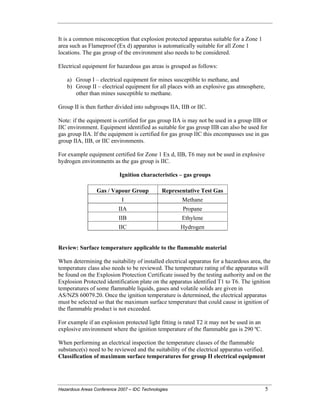What Does Roar Solutions Mean?
What Does Roar Solutions Mean?
Blog Article
The 8-Second Trick For Roar Solutions
Table of ContentsSome Ideas on Roar Solutions You Should KnowThe Roar Solutions DiariesThe Definitive Guide to Roar Solutions
In such an environment a fire or surge is feasible when three basic problems are satisfied. This is commonly referred to as the "unsafe area" or "combustion" triangular. In order to shield setups from a possible surge an approach of analysing and identifying a possibly harmful area is called for. The function of this is to make certain the proper option and installation of equipment to eventually avoid an explosion and to make certain safety and security of life.
(https://www.find-us-here.com/businesses/ROAR-Solutions-Mackay-QLD-4740-Queensland-Australia/34179229/)
No equipment ought to be installed where the surface temperature of the equipment is higher than the ignition temperature level of the offered danger. Below are some common dirt dangerous and their minimal ignition temperature level. Coal Dirt 380C 225C Polythene 420C (melts) Methyl Cellulose 420C 320C Starch 460C 435C Flour 490C 340C Sugar 490C 460C Grain Dust 510C 300C Phenolic Material 530C > 450C Aluminium 590C > 450C PVC 700C > 450C Soot 810C 570C The probability of the threat existing in a concentration high sufficient to create an ignition will differ from area to place.
In order to identify this danger an installation is separated into locations of threat depending upon the amount of time the hazardous is existing. These areas are described as Areas. For gases and vapours and dirts and fibres there are 3 areas. Zone 0 Area 20 A dangerous environment is very most likely to be present and might be present for lengthy periods of time (> 1000 hours annually) or also continuously Area 1 Area 21 A hazardous ambience is feasible however unlikely to be existing for extended periods of time (> 10 450 C [842 F] A category of T6 indicates the minimal ignition temperature level is > 85 C [185 F] Hazardous area electrical tools maybe created for use in greater ambient temperatures. This would showed on the ranking plate e.g. EExe II C T3 Ta + 60C( This implies at 60C ambient T3 will not be gone beyond) T1 T1, T2, T3, T4, T5, T6 T2 T2, T3, T4, T5, T6 T3 T3, T4, T5, T6 T4 T4, T5, T6 T5 T5, T6 T6 T6 A T Course ranking of T1 implies the optimum surface area temperature created by the instrument at 40 C is 450 C. Thinking the associated T Course and Temperature level ranking for the devices are suitable for the location, you can constantly utilize an instrument with a more strict Division score than needed for the area. There isn't a clear response to this concern sadly. It actually does depend upon the sort of devices and what repairs require to be performed. Tools with particular examination treatments that can't be done in the field in order to achieve/maintain 3rd party score. Need to come back to the factory if it is prior to the devices's service. Field Repair Work By Authorised Worker: Complex screening might not be called for however certain procedures might require to be complied with in order for the devices to maintain its 3rd party rating. Authorized personnel should be employed to do the work correctly Repair work must be a like for like replacement. New component must be taken into consideration as a straight replacement calling for no special screening of the devices after the fixing is total. Each item of equipment with a hazardous rating should be reviewed independently. These are detailed at a high degree below, however, for more detailed information, please refer directly to the guidelines.
Roar Solutions - Questions
The tools register is a detailed database of tools documents that consists of a minimum set of fields to determine each item's area, technical criteria, Ex-spouse classification, age, and ecological information. The ratio of Detailed to Shut evaluations will certainly be established by the Devices Danger, which is evaluated based on ignition risk (the probability of a source of ignition versus the probability of a flammable atmosphere )and the harmful location classification
( Zone 0, 1, or 2). Implementing a durable Risk-Based Assessment( RBI )approach is vital for making sure conformity and safety and security in taking care of Electrical Tools in Hazardous Areas( EEHA).
8 Easy Facts About Roar Solutions Shown

In regards to eruptive risk, a dangerous location is an atmosphere in which an explosive ambience is present (or may be anticipated to be present) in quantities that call for special safety measures for the construction, installation and usage of devices. hazardous area electrical course. In this write-up we check out the obstacles encountered in the work environment, the danger control measures, and the needed expertises to function securely
It is an effect of modern life that we produce, save or manage an array of gases or fluids that are deemed combustible, and a variety of dirts that are deemed flammable. These compounds can, in particular problems, develop eruptive atmospheres and these can have significant and awful effects. A lot of us recognize with the fire triangle remove any kind of one of the three elements and the fire can not happen, however what does this mean in the context of unsafe locations? When damaging this down right into its simplest terms it is basically: a combination of a particular quantity of release or leakage of a specific material or material, combining with ambient oxygen, and the presence of a resource of ignition.
In the majority of circumstances, we can do little regarding the levels of oxygen airborne, however we can have significant impact on sources of ignition, as an example electrical tools. Hazardous areas are recorded on the dangerous location category drawing and are identified on-site by the triangular "EX LOVER" indication. Here, among various other key details, areas are split into three kinds depending on the hazard, more helpful hints the possibility and duration that an explosive environment will exist; Zone 0 or 20 is deemed one of the most hazardous and Zone 2 or 22 is deemed the least.
Report this page